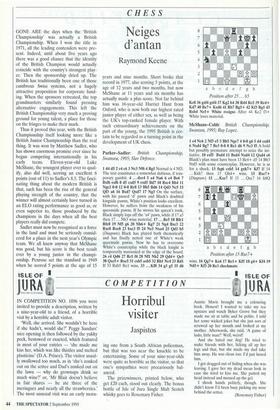CHESS
Neiges d'antan
Raymond Keene
GONE ARE the days when the 'British Championship' was actually a British Championship. When I won the title in 1971, all the leading contenders were pre- sent. Indeed, until about five years ago there was a good chance that the identity of the British Champion would actually coincide with the country's strongest play- er. Then the sponsorship dried up. The British has traditionally been one of those cumbrous Swiss systems, not a hugely attractive proposition for corporate fund- ing. When the sponsors retreated, the top grandmasters similarly found pressing alternative engagements. This left the British Championship very much a proving ground for young talent, a place for those on the fringes to make their mark. Thus it proved this year, with the British Championship itself looking more like a British Junior Championship than the real thing. It was won by Matthew Sadler, who has shown enormous promise ever since he began competing internationally in his early teens. Eleven-year-old Luke McShane, the youngest player ever to qual- ify, also did well, scoring an excellent 6 points (out of 11) to Sadler's 8.5. The fasci- nating thing about the modern British is that, such has been the rise of the general playing strength of the country, that the winner will almost certainly have turned in an ELO rating performance as good as, or even superior to, those produced by the champions in the days when all the best players really did compete.
Sadler must now be recognised as a force in the land and must be seriously consid- ered for a place in the next year's Olympic team. We all knew anyway that McShane was good, but his score is the best result ever by a young junior in the champi- onship. Penrose set the standard in 1949 when he scored 5 points at the age of 15 years and nine months. Short broke that record in 1977, also scoring 5 points, at the age of 12 years and two months, but now McShane at 11 years and six months has actually made a plus score. Not far behind him was 16-year-old Harriet Hunt from Oxford, who is now both our highest rated junior player of either sex, as well as being the UK's top-ranked female player. With such extraordinary achievements on the part of the young, the 1995 British is cer- tain to be regarded as a turning point in the development of UK chess.
Parker—Sadler: British Championship, Swansea, 1995; Slav Defence.
1 d4d5 2 c4 c6 3 Nc3 N16 4 Bg5 Normal is 4 Nf3. The text constitutes a somewhat dubious, if tem- porary gambit. 4 ... dxc4 5 a4 Na6 6 e4 Be6 7 Bxf6 exf6 8 d5 cxd5 9 exd5 Bd7 10 Bxc4 Bb4 11 Nge2 0-0 12 0-0 Rc8 13 Bb5 Bd6 14 Qd3 Nc5 15 Qf3a6 16 Bxd7 Qxd7 17 Ng3 On the surface, with his passed 'd' pawn and Black's doubled kingside pawns, White's position looks excellent. However, he suffers from the weakness of his queenside pawns. If he moves his queen's rook, Black simply lops off the `a4' pawn, while if 17 a5 then 17 ... Nb3 wins material. 17 ... Be5 18 Rfel Rfe8 19 Nf5 g6 20 Nh6+ Kg7 21 Ng4 Bxc3 22 Rxe8 Rxe8 23 bxc3 f5 24 Ne3 Nxa4 25 Qdl b5 (Diagram) Black has played both thematically and has finally netted one of White's weak queenside pawns. Now he has to overcome White's counterplay while the black knight is temporarily marooned at the edge of the board. 26 c4 Qd6 27 Rd f4 28 Nfl Nb2 29 Qd4+ Qe5 30 Qxe5 + Rxe5 31 cxb5 axb5 32 Rbl Nc4 33 Rdl If 33 Rxb5 Re! wins. 33 ...Kf8 34 g3 g5 35 d6 Ke8 36 gxf4 04 37 ICg2 b4 38 Rd4 Rc5 39 Re4+ Kd7 40 Re7+ Kxd6 41 Rb7 Rg5+ 42 KB Rgl 43 Rx134 Ne5 + White resigns After 44 Ke2 + White loses material.
McShane—Cobb: British Championship. Swansea, 1995; Ruy Lopez.
1 e4 Nc6 2 NO e5 3 Bb5 Nge7 4 0-0 g6 5 d4exd4 5
6 Nxd4 Bg7 7 Be3 0-0 8 Rel d6 9 Nc3 A bold but possibly premature attempt to seize the ini- tiative. 10 ex5 Bxd4 11 Bxd4 Nxd4 12 Qxd4 c6 Black's plan must have been 13 Bc4+ d5 14 Bb3 Nxf5 with some counterplay. However, he is in for a shock. 13 fxg6 cxb5 14 gxh7+ Kf7 If 14 Kxh7 then 15 Qh4+ wins. 15 Rxe7 + (Diagram) 15 ...ICxe7 If 15 ...Qxe7 16 h8Q wins. 16 Qg7+ Ke6 17 Rel + Kf5 18 g4+ 1C14 19 Nd5+ K13 20 Re3 checkmate.


















































 Previous page
Previous page